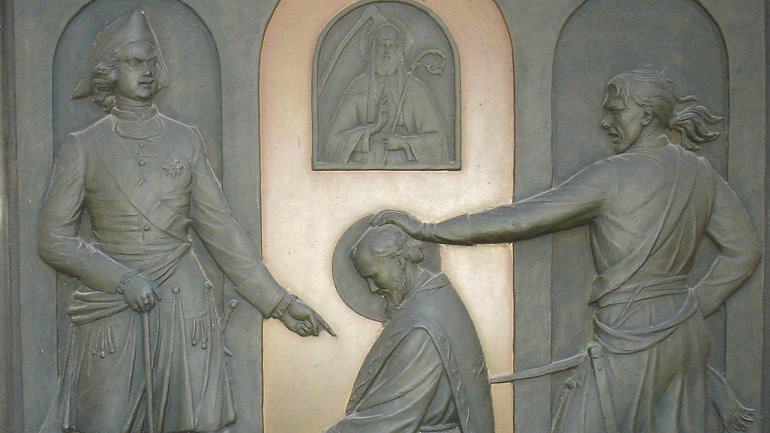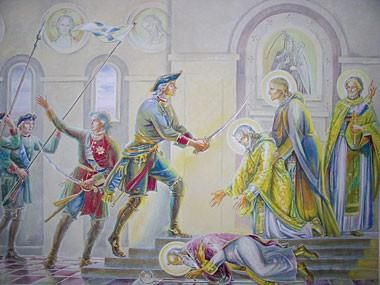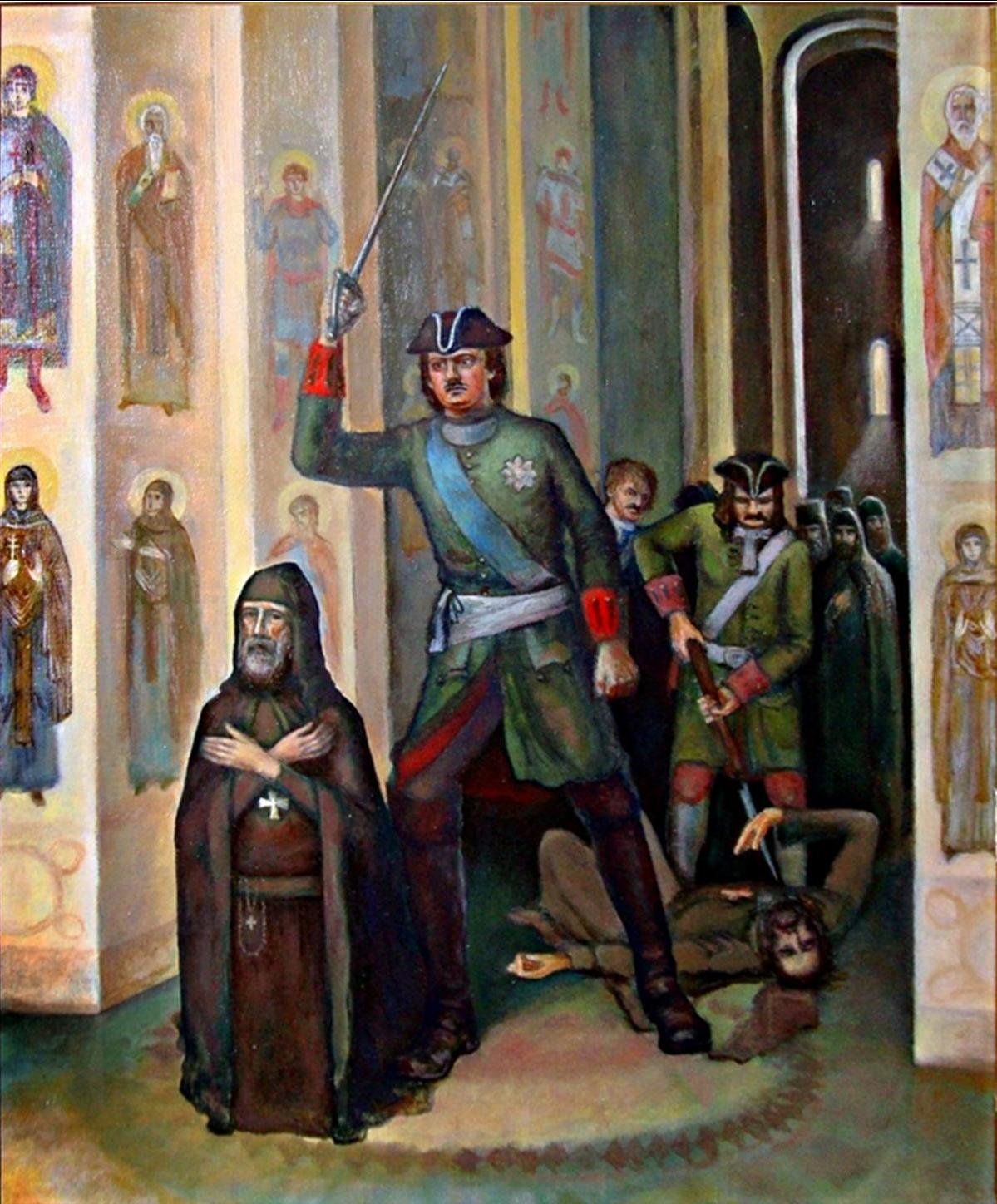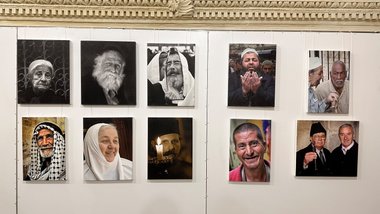Polotsk Tragedy: The History of the Murder of Uniate Monks by the Muscovites

Fr. Hieronymus Grim, OSBM
On July 11, 1705, in the city of Polotsk in northern Belarus, an event occurred that has gone down in historiography as the "Polotsk Tragedy" or "Polotsk Massacre." On this day, the Muscovite Tsar Peter I and his soldiers killed four Basilian hieromonks in the Uniate Cathedral of St. Sophia in Polotsk. This event received wide publicity in the lands of the then Polish-Lithuanian Commonwealth and marked the beginning of tribulations for the Uniate Church.
Military Context
The year was the fifth of the Great Northern War (1700-1721), a conflict between two major coalitions led by Sweden on one side and Muscovy on the other, vying for dominance in Northern, Central, and Eastern Europe. At the beginning of 1705, Peter I, with auxiliary military units, began his march through the Belarusian lands, which at that time belonged to his ally, the Polish-Lithuanian Commonwealth. The population of the territories through which the tsar and his army passed was predominantly Uniate and to a lesser extent Orthodox, belonging to the Kyivan Metropolia.
In Vitebsk, the tsar's campaign took on an anti-Uniate tone. In this city, where Blessed Josaphat Kuntsevych had once been martyred (†1623, beatified in 1643, canonized in 1867), the tsar ordered the destruction of the saint's icons and boasted that he would also burn his relics, which were kept in the Polotsk Cathedral [1, p. 63]. Forewarned of the Muscovites' intentions, the Polotsk Basilians moved the relics of Blessed Josaphat to the Radziwiłł family estates in the town of Biała in Podlachia.
"Polotsk Tragedy" on July 11, 1705
Muscovite troops led by the tsar arrived at the outskirts of Polotsk at the end of June 1705. On the evening of July 11, the tsar, already quite inebriated along with his entourage, entered the Polotsk Cathedral of St. Sophia. Inside, the Basilian monks were praying the evening service.
The tsar approached the altar of Blessed Josaphat and, pointing to his icon, asked whose icon it was. When Father Theophan Kolbechinsky responded that it was the icon of Blessed Josaphat, the tsar inquired about the significance of the axe embedded in his head. "The axe signifies that Blessed Josaphat is a martyr, as he was killed by the people of Vitebsk with this instrument, rebelling against their shepherd like disobedient sheep," answered the hieromonk. When the tsar asked, "Who authorized him to be called a saint and venerated as a saint?" Father Kolbechinsky replied that it was the Pope. "So, you are a Uniate?" the tsar asked. "Yes, a Uniate," the monk answered. The tsar then struck the father on the head with a stick, slapped him hard in the face, and, when he fell, set his English dog on him, finally piercing him with a sword [1, p. 63].
This is the beginning of the description of the "Polotsk Tragedy," which was sent on August 18, 1705, to the Congregation for the Propagation of the Faith by the Kyiv Uniate Metropolitan Lev Shlubich-Zalensky [1, p. 62].

The following day or the day after, together with Father Teofan Kolbechinsky, Fathers Kostyantyn Zayachkivsky, Yakiv Knyshevych, and Yakiv Kizikovsky perished, while seven other Basilian monks were beaten, slashed with sabers, and thrown into prison for several months. These included Brother Joseph Ankudovich, who was stabbed ten times with a saber and was thought to be dead but survived, Father Klimentiy Roznyatovsky, Brother Meletiy Kondratovich, Father Gavriil Kolenda, Father Mykhailo Kovalevsky, Father Zabrolka, and another brother.
In addition to the account of the martyrdom of the Polotsk Basilian monks sent by the metropolitan, at least six or seven other accounts are known, which differ in the sequence of torture methods or the order of the Basilians who suffered these torments. In 2000, Belarusian historian Mykhas Bovtovich collected, analyzed, and published nearly all available sources on the events that took place in Polotsk. According to this information, short biographies of the four martyred monks can be compiled.
1. Father Kostyantyn Zayachkivsky (also known as Zaykivsky), a vicar of the Polotsk monastery, is said to have been the first victim in the killing of the Basilians according to some accounts. He was killed near either the main altar or the altar of St. Josaphat. Tsar Peter I struck him with a club, severed his ears, and then ordered his hanging. Prior to his execution, however, Father Kostyantyn was tortured on an island to force him to reveal the location of church treasures and the relics of Blessed Josaphat. After his hanging, his body was thrown into the Dvina River [2, pp. 21-22].
2. Father Theophan Kolbechinsky, a preacher at the Polotsk Basilian monastery. The son of Ivan and Kataryna, born around 1674 in Lithuania. From 1698 to 1704, he studied at the Papal Jesuit College in Braunsberg [3, p. 58]. On the eve of the events, he transferred his duties to Father Klimentiy Roznyatovsky and was preparing to assume a similar position in Vitebsk or Vilna. According to some accounts, the killing of the Basilians began with him. The Tsar threw him to the ground and unleashed a massive black English dog that nearly mauled him to death before he was hanged. Other sources indicate that he was captured by Russian officers when he attempted to leave the church and was dragged to the altar of Blessed Josaphat. There, the Tsar either decapitated him or, together with Menshikov, stabbed him through with sabers. After his death, his body was presumably burned [2, p. 22].
3. Father Yakiv Knyshevych, the choirmaster. He was brutally cut by officers on the other side of the church while the Tsar and Menshikov were torturing Father Kostyantyn Zayachkivsky. After some time, he died from his wounds. After his death, his body was presumably burned [2, p. 22].
4. Father Yakiv Kizikovsky, a retired superior of the Polotsk Basilian monastery. Son of Theodor and Pelagia, born on August 19, 1665, in Volhynia. From 1691 to 1693, he studied at the Papal Greek College of St. Athanasius in Rome, where he earned a doctorate in theology [3, p. 84]. Directly before the events, he had transferred his duties as superior to Father Lavrentiy Kaparsky and was preparing to assume the position of superior of the Holy Trinity Monastery in Vilna. Different sources provide varying accounts of his death. According to some, he was captured by Russian soldiers near the monastery gate, and his fate thereafter is unknown; other sources report that he was killed by the Tsar in his cell. The "Mogilev Chronicle" states that the Tsar stabbed him with a saber while entering the church. At ten o'clock in the evening, soldiers brought him to the monastery quarters, where he died an hour and a half later. After his death, his body was presumably burned [2, pp. 22-23].

This publication is part of the RISU project "Historical Memory vs Russian World."
##DONATE_TEXT_BLOCK##










